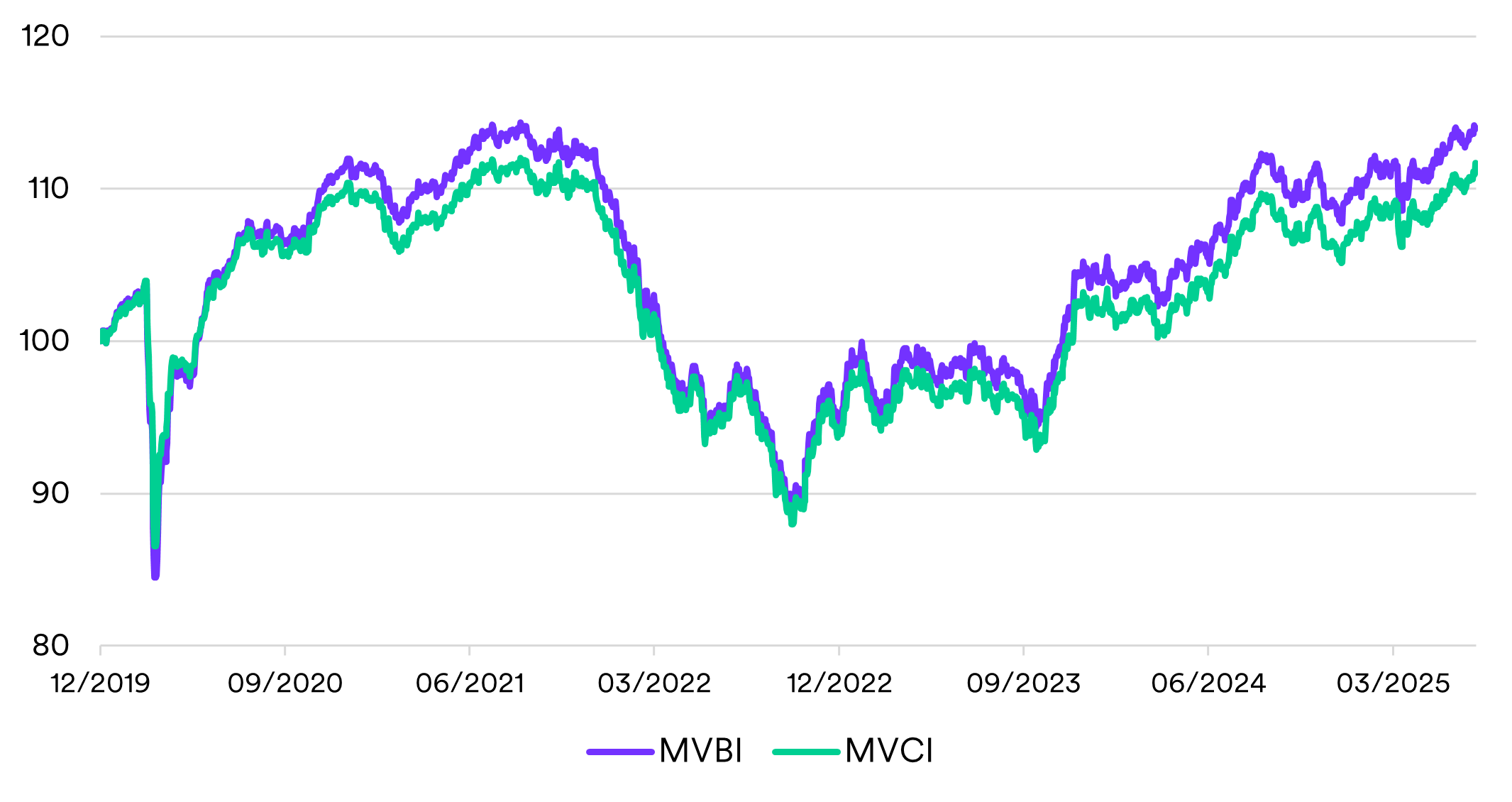In today’s credit environment, defined by tight spreads, persistent macro uncertainty, and elevated credit migration risk, investors are reassessing how they approach the boundary between investment-grade (IG) and high-yield (HY) debt.
Two dynamics are in focus:
- Fallen angels: IG bonds downgraded to HY, often triggering forced selling and spread widening.
- Rising stars: HY bonds upgraded to IG, gaining broader investor eligibility and tighter spreads.
These transitions matter not only for active credit selection but also for index design. MarketVector’s MVIS Moody’s Analytics US BBB Corporate Bond Index (MVBI) and the MVIS Moody’s Analytics US Investment Grade Corporate Bond Index (MVCI) are designed to navigate these dynamics using a rules-based approach grounded in valuation and credit risk.
To illustrate this, Figure 1 shows a scatterplot of bonds by estimated downgrade probability (x-axis) and excess spread over fair value (y-axis). Each dot represents a bond; dark dots indicate index constituents as of the July 2025 rebalancing.
Figure 1: Downgrade Probability vs. Spread: MVBI & MVCI Universe Scatterplot
.png)
Source: MarketVector Indexes. Data as of July 2025.
Constituents of MVBI and MVCI (dark dots) appear prominently in the foreground, clustered in the lower-left quadrant, reflecting the indexes’ focus on undervalued bonds with stable credit risk. The distinction between MVBI (BBB-only) and MVCI (broad IG) is evident in the spread and risk dispersion across the two panels.
A Disciplined Framework for Credit Migration
Credit migration refers to changes in issuer credit ratings over time, including both upgrades and downgrades. It is a central consideration in the design of both indexes, which seek to balance valuation with the risk of credit deterioration.
Both indexes apply two primary selection filters:
1. Excess spread over fair value, based on Moody’s Analytics valuation models
2. Probability of downgrade, using forward-looking credit risk metrics
MVBI focuses on the BBB segment, where downgrade risk is typically higher. It selects the top 10% of bonds within each sector-duration group, emphasizing undervalued issuers with relatively stable credit profiles.
MVCI applies the same framework across the full investment-grade spectrum (AAA to BBB), but with stricter inclusion criteria, selecting only the top 5% of bonds, while also enforcing tighter downgrade risk and issuer exposure limits. Its broader scope increases the likelihood of capturing rising stars, issuers improving in credit quality.
The result is two distinct yet complementary strategies that aim to capture value and mitigate risk through disciplined index construction. The chart below in Figure 2. compares the historical performance of the MVBI and MVCI indexes, highlighting how each strategy has responded to market cycles and credit conditions.
Figure 2: Performance Comparison – MVBI vs. MVCI

Source: MarketVector Indexes. Data as of July 2025.
Structure Meets Strategy to Better Navigate Credit Risk
In a crowded and cautious credit market, MVBI and MVCI indexes offer complementary approaches to balancing value and credit quality across the investment-grade spectrum. By combining excess spread analysis with downgrade probability, they aim to capture:
- Opportunities in rising stars with improving fundamentals, and
- Protection against fallen angels through proactive credit filtering.
By integrating credit-aware indexing into fixed income strategies, investors can better navigate the investment-grade vs. high-yield divide, while staying aligned with long-term credit trends.
For more information regarding the eligibility criteria, please refer to the index guide (MVBI, MVCI).
About the Author:
Antonio Fons Palomares is an Index Specialist at MarketVector Indexes™ ("MarketVector"). He is primarily responsible for the research, development, and maintenance of MarketVector Indexes™ across all asset classes. Antonio holds a Master's Degree in Financial Engineering from the Business Administration Institute (IAE) of the University of Poitiers, France, and a Bachelor's Degree in Economics and Business Administration from the University of Paris-Saclay, France. He has cleared the CAIA Level 1 exam.
For informational and advertising purposes only. The views and opinions expressed are those of the authors but not necessarily those of MarketVector Indexes GmbH. Opinions are current as of the publication date and are subject to change with market conditions. Certain statements contained herein may constitute projections, forecasts, and other forward-looking statements, that do not reflect actual results. It is not possible to invest directly in an index. Exposure to an asset class represented by an index is available through investable instruments based on that index. MarketVector Indexes GmbH does not sponsor, endorse, sell, promote, or manage any investment fund or other investment vehicle that is offered by third parties and that seeks to provide an investment return based on the performance of any index. The inclusion of a security within an index is not a recommendation by MarketVector Indexes GmbH to buy, sell, or hold such security, nor is it considered to be investment advice.
Get the latest news & insights from MarketVector
Get the newsletterRelated:




